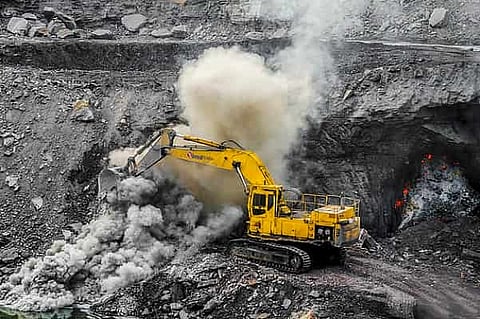

New Delhi: Nearly a week after three women were killed in a land subsidence incident in Jharia coalfields in Dhanbad, Jharkhand, the Ministry of Coal has released a statement in which it has said that due to the government’s efforts, the area under fire in Jharia has reduced significantly and the resettlement and rehabilitation work is being conducted in well-organised phases. “The Ministry of Coal has been closely monitoring fire incidents and rehabilitation efforts. High-Power Central Committee (HPCC) meetings, chaired by the Secretary, Ministry of Coal, were held to oversee the progress of the Jharia Master Plan. The fire-affected area has significantly reduced from 77 sites (pre-Nationalisation) to 67 sites (as per Jharia Master Plan, 2009) covering 17.32 sq km to 27 sites covering 1.8 sq km according to surveys conducted in 2021,” the government said in a statement.
Without elaborating on the timeline by which the government is aiming to finish the resettlement and rehabilitation work, the Ministry of Coal said, “In the face of formidable challenges, the Ministry of Coal remained resolute and committed to bringing about positive changes in Jharia. The resettlement and rehabilitation work are being conducted in well-organised phases.” The Jharia Master Plan was approved in August, 2009 with an implementation period of 10 years and pre-implementation period of two years with estimated investment of Rs 7.112.11 crores. The masterplan identified 595 sites in Jharia that needed to be rehabilitated, covering an area of 25.70 square kilometres. The plan has expired in 2021 and residents are still waiting for rehabilitation. Two highly-placed sources who spoke to Energy Watch said that the government is hoping to wrap up the resettlement and rehabilitation process in the next four years as the government has set a target of producing 100 MT of coking coal, most of which is locked up in Jharia.
“Even after the expiration of the Jharia Master Plan in August 2021, the Ministry of Coal continues to review the progression of activities undertaken by BCCL (Bharat Coking Coal Limited) and JRDA (Jharia Rehabilitation and Development Authority) on a biweekly and monthly basis. Additionally, the ministry is continuing to fund ongoing projects that were undertaken during the expiration of the Jharia Master Plan for fire dousing and rehabilitation, in consultation and coordination with the state government. The efforts of the Ministry of Coal in tackling the fires, resettling the affected families, and ensuring the sustainable extraction of coal have laid the groundwork for a brighter future,” said the Coal Ministry.
The complexities in the implementation of the Jharia Master Plan ranges from technological limitations in assessing underground fires to the perception among affected families that the plan was aimed at acquiring land for coal mining rather than addressing fire and subsidence hazards, said the Coal Ministry. “Non-acceptance of the rehabilitation package by land owners, the absence of a legal framework for land rights transfer to JRDA complicated the process of rehabilitation,” it added.
Three categories of the population need rehabilitation — legal title holders, non-legal title holders and families of BCCL employees. Initially, BCCL was to construct 25,000 houses, but due to superannuation and other reasons, the number of required houses reduced to 15,713. BCCL has constructed 11,798 houses till date, and the remaining are under construction. Out of the 15,713 houses, 8,000 houses will be allotted by JRDA to legal title holder families.
“While facing numerous challenges in the implementation of the approved Jharia Master Plan, the Ministry of Coal has displayed firm determination and dedication to tackle them head-on. Despite the array of challenges, the Ministry of Coal worked tirelessly to overcome each obstacle and demonstrated remarkable resilience and achieved significant progress,” said the Coal Ministry. Last year, the government decided to offer only cash compensation instead of housing to the remaining affected families.
Coal mines in Jharia Coalfield dates back to 1916 when the first incidence of fire was reported. Since then, a number of fire incidents have occurred within the overburden debris. Prior to nationalisation, these mines were privately owned and operated with a profit-driven approach and mining methods were unscientific with least concern for safety, conservation and the environment. “This practice has resulted in severe land degradation, subsidence, coal mine fires and other socio-environmental problems,” said the government.
In 1996, the government constituted a High-Power Committee under the chairmanship of the Secretary, Ministry of Coal, to review the problems of fire and subsidence in Jharia coalfields. To address these fires and rehabilitate the residents in the vicinity, two masterplans were formulated in 1999 and later revised and updated in 2004 which was based on enhanced fire dealing efforts of BCCL and the Ministry of Coal. The master plan covered two aspects — focus on fire management, which included identification of fire areas, selection of technologies to deal with the fires, prioritising the implementation and assessment of tentative fund requirement and rehabilitation and resettlement of the affected people due to fire and land subsidence, including identification of affected sites, resettlement sites and assessment of tentative fund requirement.
